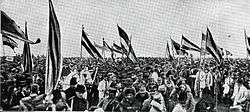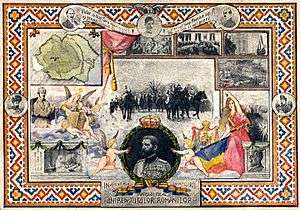Great Union Day
| Great Union Day | |
|---|---|
 The National Assembly in Alba Iulia (December 1, 1918) | |
| Official name | Romanian: Ziua Naţională a României |
| Also called | Romanian: Ziua Marii Uniri |
| Observed by | Romania |
| Celebrations | Military parades (most notably in Alba Iulia and Bucharest), fireworks |
| Observances | Te Deum at the Alba Iulia Orthodox Cathedral |
| Date | 1 December |
| Next time | 1 December 2017 |
| Frequency | annual |
Great Union Day (Romanian: Ziua Marii Uniri, also called Unification Day[1]) occurring on December 1, is the national holiday of Romania. It commemorates the assembly of the delegates of ethnic Romanians held in Alba Iulia, which declared the Union of Transylvania with Romania.
This holiday was set after the Romanian Revolution and it marks the unification of Transylvania, but also of the provinces of Bessarabia and Bukovina with the Romanian Kingdom, in 1918.
Prior to 1948, the national holiday of Romania was set to be on May 10, which had a double meaning: it was the day on which Carol I set foot on the Romanian soil (in 1866), and it was the day on which the prince ratified the Declaration of Independence (from the Ottoman Empire) in 1877.
In Communist Romania, the date of the national holiday was set to August 23 to mark the 1944 overthrow of the pro-fascist government of Marshal Ion Antonescu.
History
Alba Iulia National Assembly


On December 1, 1918 (November 18 Old Style), the National Assembly of Romanians of Transylvania and Hungary, consisting of 1,228 elected representatives of the Romanians in Transylvania, Banat, Crişana and Maramureş, convened in Alba Iulia and decreed (by unanimous vote)
| “ | the unification of those Romanians and of all the territories inhabited by them with Romania. | ” |
The Resolution[2] voted by the National Assembly stipulated also the "fundamental principles for the foundation of the new Romanian State". It was conditional, and demanded the preservation of a democratic local autonomy, the equality of all nationalities and religions.
The Assembly also formed from 200 of its members, plus 50 co-opted members a High National Romanian Council of Transylvania, the new permanent parliament of Transylvania.
The next day, on December 2, 1918, the High National Romanian Council of Transylvania formed a government under the name of Directory Council of Transylvania (Consiliul Dirigent al Transilvaniei), headed by Iuliu Maniu.
On December 11, 1918, King Ferdinand signed the Law[3] regarding the Union of Transylvania, Banat, Crişana, the Satmar and Maramureş with the Old Kingdom of Romania, decreeing that
| “ | The lands named in the resolution of the Alba-Iulia National Assembly of the 18th of November 1918 are and remain forever united with the Kingdom of Romania. | ” |
Declaration of the holiday
Resolution #903 of the Council of Ministers on August 18, 1949 had marked August 23 as the national holiday. Law 10/1990, declared on August 1, 1990, moved the national holiday to December 1.[4] The law does not specify the significance of this day as the national holiday. It was adopted in 1990 by a parliament dominated by members of the National Salvation Front and promulgated by the president Ion Iliescu. The decision combated in some amount sympathy with the tradition of Romanian monarchy, associated with the day May 10, but also disappointed the anti-communist opposition, who wished for the national holiday to be moved to December 22.
The choice of December 1, though not explicitly declared in the law, referred to the unification of the provinces of Transylvania, Banat, Crişana, and Maramureş with Romania in 1918. The choice of this day as a national holiday was seen as an affront to the Hungarian minority of Romania, which signified for them a loss in political power.[5]
First celebration
The first December 1 national holiday saw the largest celebrations in Alba Iulia, the location in which the union of Transylvania with Romania was signed. They were marked by significant political polarization: Corneliu Coposu, then the leader of the anticommunist opposition, was interrupted several times during a speech by boos from the crowd.[6] Petre Roman, then the prime minister, showed such pleasure at these repeated interruptions that Ion Iliescu had to gesture to him to stop. This signal was captured on filmed and spread widely by the mass media.
See also

References
- ↑ CIA World Factbook, Romania – Government
- ↑ Romanian Institute for Cultural Remembrance, The Resolution of the National Assembly in Alba Iulia on December 1, 1918
- ↑ Romanian Institute for Cultural Remembrance, Law regarding the Union of Transylvania, Banat, Crişana, the Satumare and Maramureş with the Old Kingdom of Romania
- ↑ Law 10 from August 1990
- ↑ "Marko Bela: Noi, maghiarii, nu putem sarbatori la 1 decembrie". 27 November 2008.
- ↑ "Cum a fost sărbătorit 1 decembrie 1990".
Bibliography and external links
- National Day of Romania site with information about the event and webcam showing 2005 celebrations (by the Alba County Prefecture)
- Union of Transylvania with Romania (in Romanian)